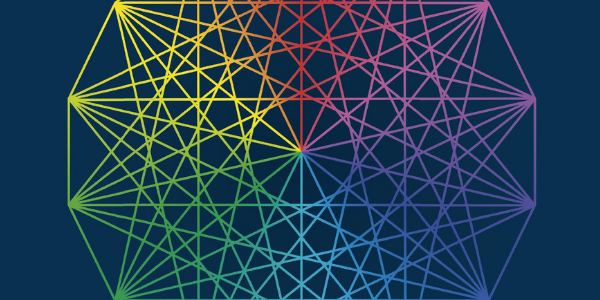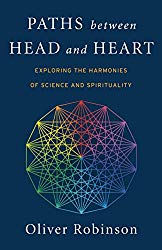
Paths Between Head and Heart: Exploring the Harmonics of Science and Spirituality, by Oliver RobinsonO-Books, 9781782799001, 288 pp., 2018
We have finally stepped into the vision of the Aquarian Age of seeing the bigger picture and having the ability to create those bridges of connection between what is seen and what has long been the stuff of imagination and speculation. Paths Between Head and Heart: Exploring the Harmonics of Science and Spirituality by Oliver Robinson engages the reader in becoming receptive to the correlations between the factual and provable world of science and the still indefinable and often immeasurable world of spirituality. The whole of which is a rather large undertaking to be written by a working scientist.
When Albert Einstein was in his late fifties, he wrote an article called “Physics and Reality” in which he concluded that science rests on unknowable mysteries…. that the theories and formulae of scientific knowledge convey only part of reality. Beyond them, he surmised, lie the immeasurable, the inexplicable and even the miraculous.1
I am curious about what has been the motivation for a scientist to pursue and explore the more esoteric philosophies and ultimately write a book about these topics. And, I have read many books where the information has been sterile and wholly based on detached analysis of what has been gathered for research purposes. Robinson’s offering is clearly not one of those books. He holds a BSc in psychology with counseling degrees and is a senior lecturer in psychology at the University of Greenwich. But beyond those credentials, one has only to look at this book’s endnotes to see the thorough and in-depth research that went into the writing of Paths Between Head and Heart using an impressive collection of concise scientific texts and well-respected staples of writings on the matters of spirituality. The result is a book wherein the reader can feel the resonance of what has been experienced and learned from these materials by the author, giving this book a depth of authenticity that motivates the reader’s own curiosity to know more.
The first chapter, aptly titled “Setting the Scene,” does exactly that. Robinson covers all of the basics of scientific and spiritual inquiry that “support the case that science and spirituality are harmonious partners in the quest for truth, well-being and wisdom.”2 This chapter prepares the reader for a style of writing throughout the subsequent chapters that effectively makes some of the more complex scientific theories and the varied layers of spiritual practice relatable and understandable by anyone. I especially appreciated the time taken by the author to compare the deeper meanings of the words “spirituality” and “religion,” often used interchangeably, and the threads of commonality held in the semantics of each, while retaining separate and very concise relevance in the selection of spirituality to the intention of this book’s premise.
In “Entangled Histories,” Robinson begins by positing an observation regarding the parallel nature of exponential growth in the past four centuries of science and spirituality. He continues to state that the most impactful times of these parallels have catalyzed growth in both of these pursuits during historical times of revolution. Each stimulating the other to find response to the questions that arise as more knowledge (and scientific evidence) is gained that informs what was thought to be the random nature of spiritual and mystical findings.
For the sake of clarity, Robinson structures these centuries into four ages: “the age of rebellion, the age of wonder, the age of paradox and the age of interaction.”3 This structure lays the foundation for the remainder of the book in providing a definition of the workings within each of these ages and their potential. Even for someone, like myself, who rarely enjoys the historical details of a topic, Robinson presents the information in a way that is both interesting and informative.
Chapter titles such as, “Impersonal-Personal,” “Thinking-Feeling,” “Mechanism-Purpose,” “Verbal–Ineffable,” and the remaining chapters, further support the notion of key notes of spiritual and scientific concepts as cohorts that easily and routinely share similar goals of outcome. This outcome sought is the ageless pursuit of inquiry by every means possible into the purpose of existence in this very manifest form in a world that is both overt and hidden. These pairs of opposites demonstrate the natural and cosmic function of harmony, which is the striving towards finding the commonalities within each that provides a union of the two somewhere along the spectrum created. Much like the scales of balance, these points of cohesion move in accord with the dynamics of what a particular age has as focus and those individuals of both science and spirituality who become the guiding force of those dynamics.
Robinson clearly understands the mechanisms of scientific inquiry and the need for a mystical experience to achieve the harmonious action between the disciplines that he speaks of. Paths Between Head and Heart is filled with exercises and experiments in each chapter that provide the reader opportunities for personal immersion and the engagement of first-hand experience that appeals to both the scientist and the spiritual practitioner. There is no lack of methodical approach while simply allowing the results to flow of their own accord.
Two of my favourite exercises were found in the fourth chapter, “Impersonal-Personal.” The first was an exercise for “impersonal awareness, subtitled “Getting ‘360 Feedback’ on Your Personality.” It reads “taking an unbiased and impersonal view of oneself takes a lifetime of practice and development… This exercise will help you to become aware of any biases or blind spots in your view of yourself.”4 I found this exercise to work on both my analytical processes and the emotional components associated with what I learned about myself. This exercise was reminiscent of the prominent spiritual adage of strivings to “know thyself” and in so doing, revealling more of the sacred mysteries and having more effect on the physical world.
The second exercise will be familiar to many Here titled “Practice for Interpersonal Awareness: Random Acts of Kindness,” the focus of this exercise is one of “recognizing that another being is a conscious subject worthy of your care and empathy, and then doing something about it.”5 I appreciated the inclusion of familiar themes within many of the exercises that worked to make me more receptive to those that were definitely more challenging.
As I moved through the chapters and began to incorporate the scientific theory presented and the tactile and kinesthetic exercises of discovery, I continued to realize that much of what has been revealed in the matters of scientific discovery have been guided by the process of intuitive inquiry. And, that although some may consider them strange bedfellows, science and spirituality have been companions all along. This is a key understanding in seeking ways to implement the bridging to be made if we are to continue to uncover the mysteries of science and the reality of spiritual philosophy.
Science has no formal training in cultivating intuition, so it is to spiritual exercises that a person can turn to cultivate practices in unknowing and openness.6
The epilogue, “The Interconnected Age,” is by and far my favourite, as it brought the realization that all we are and perceive ourselves to be in this space and time is connected by the reciprocity of what is provable beyond doubt and what is ineffable in its very nature. Robinson writes, “Interconnection and interdependence bring the genuine possibility of being more united as a species and more able to enact initiatives that serve the needs of the planet as a whole… Science and spirituality provide crucial resources for the head and heart to be willing parts of the interconnected nexus.”7
Paths Between Head and Heart: Exploring the Harmonies of Science and Spirituality is a book I recommend that one return to regularly. It has been skillfully written to stimulate within the reader the sense of awe and wonder that all great scientific discoveries have benefited from as the catalyst towards revealing their workings. And, it provides the spark of intuitive inquiry within the spiritual practitioner who yearns to peek behind the veil of the intangible and bring into manifestation a vision of the mystery of a reality informed by head and heart.









